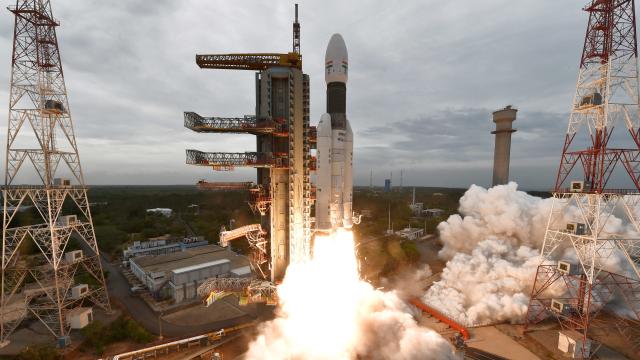The Chandrayaan-2 mission is officially off to a promising start, as India vies to become the fourth nation to land on the Moon.
The Indian Space Research Organisation (ISRO) launched the three-stage GSLV Mk-III rocket on Monday, July 22 at 2:43 p.m. local time from the Satish Dhawan Space Centre at Sriharikota, an island off the coast of Andhra Pradesh, according to a press release from the space agency.
The rocket successfully deployed its cargo — the 3840 kilogram Chandrayaan-2 spacecraft — into Earth orbit a short time later. ISRO says the spacecraft is in “good health” and moving in the “right direction,” as the Times of India reports.
The rocket was originally scheduled to go up on July 15, but ISRO had to cancel the launch due to technical issues. Yesterday’s successful effort was met with intense relief, after fears that the launch might not happen at all due to the technical snag and short launch window.
Over the next few days, mission controllers will use Chandrayaan-2’s onboard propulsion system to perform a series of orbital adjustments. The spacecraft is not taking a direct path to the Moon. Instead, it will perform a series of ever-widening Earth orbits until it’s far enough away to be captured by the Moon’s gravity. This process will take 48 days, after which time the spacecraft will be close enough to the Moon such that it can dispatch the Vikram lander to the lunar surface.
The Vikram lander, named in honour of Vikram Sarabhai, a pioneering figure in the Indian space program, will attempt to make a soft landing on September 7, 2019. The probe will descend toward the lunar surface at a rate of 2 metres per second and land on a high plain between two craters, Manzinus C and Simpelius N, at the Moon’s south pole region, according to an ISRO press kit.
If successful, India will become just the fourth country in the world to land a spacecraft on the Moon, the others being the U.S., the Soviet Union and China. Earlier this year, Israel’s Beresheet Probe crashed on the Moon, dashing its hope to do the same. The Chandrayaan-2 mission will be the first to explore the Moon’s south pole region.
This is the second time India has sent a spacecraft to the Moon. In 2008, ISRO launched Chandrayaan-1, which involved a lunar orbit and an impactor, the latter of which deliberately crashed into the Moon.
Once on the lunar surface, the Chandrayaan-2 mission is expected to last for one lunar day, which is roughly equal to 14 Earth days. The Vikram lander will deploy Pragyan, a six-wheeled robotic vehicle (Pragyan means “wisdom” in Sanskrit). This rover will travel a maximum 500 metres from the landing site, moving at a rate of 1 centimetre per second. Neither Vikram nor Pragyan are equipped to survive the lunar night, in which temperatures can drop as low as -170 degrees Celsius.
During the 14 Earth days in which Pragyan will be active, the rover will use its onboard particle x-ray spectrometer and laser spectroscope to study the chemical composition of the lunar surface near the landing site. Meanwhile, the Vikram lander will try to detect moonquakes, measure the Moon’s thermal conductivity (the degree to which the lunar surface can conduct electricity) and study the lunar ionosphere (the zone that’s ionized by solar and cosmic radiation). Vikram will be able to communicate with Pragyan, the Chandrayaan-2 lunar orbiter and mission controllers back on Earth.
As for the Chandrayaan-2 orbiter, it will function in lunar orbit for about one year and it will observe the surface from a height of around 100 kilometres. The orbiter is equipped with a suite of instruments that will allow for topographical scans of the lunar surface, measurements of the Moon’s chemical composition and surveys of lunar minerals and (possibly) water.
The orbiter will also study the Sun with a solar x-ray monitor. Happily, the orbiter is also equipped with a high-resolution camera, so we should get to see some fantastic photos of the Moon’s south pole region. In all, the Chandrayaan-2 mission involves 13 different elements, all of which were developed in-house by ISRO.
Indeed, this is very much a “we did it ourselves” mission for India. The country is striving to become a space power in its own right and it hopes to show the world that it can do a lot more than just launch satellites into space.
In March of this year, India purposefully shot down one of its own satellites to showcase its growing influence in space. Looking ahead, a third Chandrayaan mission is scheduled for sometime around 2023 or 2024 (possibly in conjunction with JAXA, Japan’s space agency).
There’s even talk of putting astronauts in space by 2022 and sending a probe to Venus by 2023.
“India wants to show, especially since Prime Minister [Narendra] Modi came into office, that India is a major power and that India has to be treated as a major Indo-Pacific power,” Rajeswari Pillai Rajagopalan, head of the nuclear and space policy initiative at the Observer Research Foundation, told CNN.
But this is all for the future. For now, India still needs to safely place the Vikram lander on the lunar surface, a feat scheduled for September 8. As Israel learned earlier this year, nothing should be taken for granted. Space, as it’s often said, is hard.
